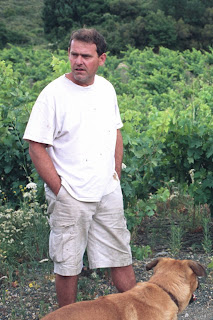"Part one" posted on WineWriting.com ran a bit like this, just to regurgitate a bit of background and my thoughts: The first of its kind, I/they believe (? and set to become a regular event I hope), an international wine competition in celebration of one of my fav varieties, Grenache / Garnacha / Garnatxa / Cannonau: red, white, rosé and fortified wines. And absolutely why not, I hear you say. Ah, yes, Cannonau: it took me a while too to remember that Sardinia's Cannonau di Sardegna (click for Part 3...) red is made from what they call Grenache!
 |
Old terraced Grenache, Banyuls-sur-mer By Vi Erickson |
I was on one of the tasting panels in Perpignan on 24th January; my table of tasters (two Spanish - erm, one Valencian, one Catalan - three French and yours truly) sampled and marked about 30 wines: one flight of Spanish rosés, one of Cannonau (my pick of those appear on my other blog - click on the link at top of page) and one of Roussillon 'table' reds. Being held in Perpignan, there were naturally a lot of local entries, which is probably reflected in the amount of medal winners from this region (and some good wines of course). Then again, most of the world's Grenache is planted in France - split between the Rhone valley, Roussillon and Languedoc - and Spain, Garnacha's spiritual home (I have/found contradictory info disagreeing over whether Spain or France has the most!). There were also some entries from Australia (probably not as many as there could/should have been?) and South Africa (again, medal winners and my favs will appear on WW.com), accompanied by surprise samples from Brasil and Republic of Macedonia! But what about California? I believe the main criterion applied for the contest was for large-majority Grenache (red, white, grey or 'furry'...) wines, which perhaps also explains the dominance of the Roussillon and lack of Chateauneuf-du-Pape or Languedoc in the 'French category', although you'd still have expected more Rhone wines in the medal line-up.Talking of which, this is where I might make myself unpopular. I counted 163 Gold and Silver medals including nine Trophy winners: out of only 364 wines tasted, that's nearly 45% of them, which is too high a proportion compared to other international competitions; and in fact OIV regulations, the organisation that dreamed up the frankly stupid 'official' system used, apparently state that "awards are limited to 30% of samples entered..." I've come across this system before, where you have to allocate a set amount of marks to all aspects of each wine, including e.g. colour and clarity as if that really matters when making a quality judgement. Especially since Grenache isn't naturally known as a variety with lots of rich colour (you can if you really extract it), compared to say Syrah or Cabernet. Anyway, this very long-winded methodology does at least add up to 100, but it's more generous - or the opposite - than the 100 point system used by some wine critics. Scoring works as follows: 84 to 87 Silver medal, Gold 87 to 92 and Trophy 92 to 100 (see what I mean). It's too easy to award too many or too few marks to a wine by adding them all up for each 'category' (visual, olfactory, mouth-feel, overall impression and totally subjective 'typicity'), as you're supposed to. So I judged them applying the 'traditional' 100-pointer in my mind while asking myself: "is this really a silver or gold wine?" Then did the silly math afterwards.
Rant over: you have to use some scoring system or other obviously. And I'm certainly not knocking any attempt to promote great wines made from Grenache from around the world. The nine 'trophy' winners were as follows, which include a fair few Vins Doux Naturels fortified reds and 'whites' (red highlight = link to profile on this blog):
Château de Péna Hors d'âge AOP Rivesaltes Tuilé, Roussillon.
Dom Brial 2010 AOP Rivesaltes Grenat, Roussillon.Domaine Rossignol 2008 AOP Rivesaltes Ambré, Roussillon.Albera En croisade Hors d'âge AOP Rivesaltes Ambré, Roussillon.
GT-G 2010 LePlan-Vermeersch AOP Côtes du Rhône Villages.
Lafou Els Amelers 2011 Roqueta DO Terra Alta white, Catalonia.
Saint Roch Kerbuccio 2011 Maison Lafage AOP Maury Sec, Roussillon. Sartiglia 2011 Azienda Vinicola Attilio Contini DOC Cannonau di Sardegna (actually my top wine in our flight from Sardinia: see WW.com link at top).
Sur Grains 2011 Domaine Boudau AOP Rivesaltes Grenat, Roussillon (my note below).
The full results are viewable here: www.grenachesdumonde.com.
My favourites from the Roussillon and Rhone Valley (tasted in the competition blind, that evening at a food & wine tasting bash or the previous night over dinner) were as follows, including the first outing, for me at least, of some exciting Maury Sec dry red wines (the appellation rules were amended from vintage 2011 to embrace 'dry' and fortified sweet reds from the same area based on Grenache). Medals awarded are in brackets and/or my 100-point style score afterwards: Sans plus attendre 2010, Domaine Modat Côtes du Roussillon Villages Caramany (Gold medal) - attractive white pepper, sweet cherry and liquorice; firm vs rounded with powerful yet balanced finished. 90Domaine de Bila-Haut 2010 M. Chapoutier, Côtes du Roussillon Villages Latour de France (Gold) - young lively fruit, rich black cherry with minty spicy edges, tight fresh finish showing a bit of class too. 87+Le Clos du Fourat 2011 L'Etoile AOP Collioure Rouge (Gold) - nice peppery style with quite rich dark fruit, rounded oak-tinged palate but has attractive tannins and ripe fruit too. 86Cuvée Centenaire white 2010 Domaine Lafage (large proportion of Grenache blanc I believe) - shows a touch of wood layered with attractive yeast-lees notes and buttery hazelnut aromas/flavours and floral 'mineral' edges, rounded and quite soft with fair weight and rich exotic fruit vs hint of fresh acidity still; good with creamy porcini soup appetizer. Nicolas vieilles vignes 2011 Maison Lafage, Côtes Catalanes (15% alc.) - attractive Grenache nose, sweet fruit with peppery edges and punchy mouth-feel, firm and structured with tasty ripe fruit; good (Silver). Cuvée Léa 2011 Maison Lafage, Côtes du Roussillon Les Aspres (14%) - ripe resin-y and rich vs solid framework, closes up on its long finish; needs a little time to open up (Silver). Montpin 2011 Domaine Pouderoux, Maury Sec - lovely Grenache fruit with peppery intensity, again tasting a bit austere on the palate at the moment (like many 2011s) but it's promising (Silver). Légende 2011 Mas Amiel, Maury Sec - delicious juicy ripe Grenache fruit, powerful and peppery palate with tight firm long finish; very nice wine. Grenache blanc vieilles vignes 2011 Clos des Fées (14.5%) - rich rounded and powerful, concentrated with honeyed vs aniseed flavours, rounded finish vs a touch 'mineral' too. Lovely white wine served by the owner/winemaker, the ironically philosophical and down-to-earth Henri Bizeul himself.
Vins Doux Naturels
As a 'by the way', we discovered from Eric Aracil, the Roussillon Wines' export guy who offered the first two below for tasting, that in terms of labelling "Vintage" style red VDNs, winemakers are moving to a uniform use of 'Grenat' in Rivesaltes and Maury and 'Rimage' for Banyuls.
2011 Rivesaltes Grenat 'sur grains' Domaine Boudau (fortified 'on skins', aged in inert concrete vats) - lovely lively black cherry and liquorice fruit with spicy pepper and violet notes, tasty black fruit palate vs firm tannins and nice cut, delicious style drinking well already although will improve in bottle no doubt (Trophy).
2011 Maury Mas Karolina (similar winemaking although part-aged in demi muids size casks = usually about 450 to 600 litre capacity) - more closed up to start, hints of lush dark blackberry fruit, powerful ripe and sweet with peppery tones, bigger more structured wine than above, less 'fruity' even and beginning to show more savoury characters; good stuff, for keeping.
2008 Maury Domaine Thunevin Calvet - enticing mix of dark fruity and peppery vs savoury meaty development, still has a bit of 'kick' yet is also becoming quite soft on the finish. 2010 Maury Serre Romani (15.5%) - attractive aromatic violet notes, sweet vs grippy palate, nice fresher 'lighter' style. Their 2011 won a Gold by the way. 2003 Rivesaltes ambré 2003 Vignoble de Constance et Terrassous (merger of the Thuir and Terrats co-op wineries) - delicious pecan/walnut aromas with toasted hazelnut and Amontillado-style oxidising maturing notes, well balanced and complex finish; still very much alive actually. The day after the competition, a group of us visited Coume del Mas and Cave Abbé Rous in Banyuls-sur-mer and Domaine Sarda-Mallet on the outskirts of Perpignan: updates on these estates/wineries to follow.
Châteauneuf-du-Pape including some tit-bits of background presented by Michel Blanc, director of the producers' federation:
The Châteauneuf appellation area comes to about 75% Grenache overall, pruned to old bush vines which are handpicked "forcing them to sort the grapes in the vineyard or cellar." Grenache is planted up to about 150 metres altitude with less of the region's characteristic big pebbles as you go up the slopes. The vineyards are often swept by the powerful Mistral wind and see little but heavy rain when they get it. Lots of Grenache was planted here for the first time in the early 20th Century - only 30% was allowed until the end of the previous century - although "we're now looking again at our other varieties, such as Counoise, in the face of hotter summers to get better balance in the wines."
2010 Cornelia Constanza Domaine de la Solitude (100% Grenache, 10% of it aged in new oak) - aromatic floral dark cherry and liquorice nose with volatile fiery notes, punchy vs soft palate with sweet peppery fruit; attractive style even if a little 'hot'.
2010 Domaine Pierre Usseglio - lovely ripe Grenache style with liquorice and pepper, punchy vs soft and fruity palate, nice dry vs rounded tannins, quite fiery yet concentrated and complex; not over the top in the end.
2010 Grenaches de Pierre Domaine Giraud (15% alc.) - wow, quite 'hot' vs lush and spicy warm Grenache fruit; too powerful and unbalanced though: goes to show that 100% isn't necessarily best.
My pick of the Spanish rosados and Cannonau di Sardegna reds we tasted (will) feature on WW.com (click on highlighted links), along with a few choice cuts from the succinct presentations given in the afternoon on Grenache and pen names in Sardinia, Aragon, Catalonia and Australia.
















